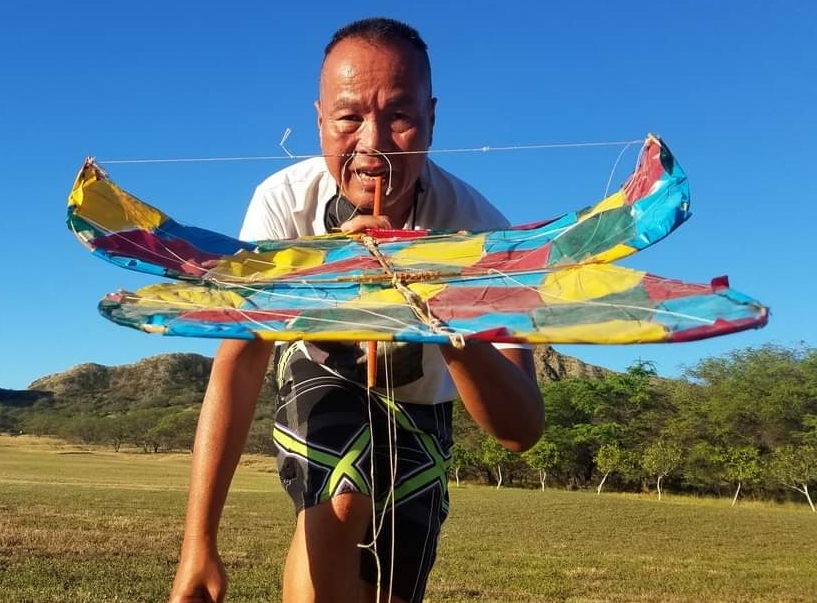HONOLULU (KHON2) — Up, up, up and away they go. Kites have fascinated young and old for a long, long time. In Hawaiʻi, it is believed that the demi-god Maui invented the kite and learned how to use the wind to his advantage.
William Drake Westervelt was a renowned historian of Hawaiʻi’s past, and he found a great deal of history linking Hawaiʻi to the invention of kites.
Westervelt notes that kānaka maoli myths uniquely attribute the enjoyment of kite flying to the gods, unlike other Pacific Ocean myths. The god Maui crafted an enormous kite, larger than any house of his era, using strong fibers from the olona plant. He imbued both the kite and its string with magical powers.
Despite these enhancements, when Maui launched his kite, it ascended very slowly into the sky due to insufficient wind.
Maui’s need for more wind led him to an old priest in Wapio Valley on what we now call Hawaiʻi Island.
Westerveld describes a kanaka priest named Kaleiioku who controlled the winds by trapping them in a calabash called ipu-makania ka maumau, or “the calabash of the perpetual winds”.
Maui, needing wind for his kite flying, asked the priest to release the winds near the Wailuku River in Hilo. As the winds were released, Maui stood on the riverbank, where his footprints were said to be imprinted in the lava rocks due to the force he exerted to hold his kite. Overcome with excitement as the kite soared, Maui joyfully shouted a challenge across the coastal sea towards Waipio.
This was his prayer:
“O winds, winds of Waipio,
In the calabash of Kaleiioku.
Come from the ipu-makard,
O wind, the wind of Hilo,
Come quickly, come with power.”
The priest opened the calabash, releasing the strong winds of Hilo, which rushed along the seacoast. As the winds reached Hilo Bay, they heard Maui’s voice calling out.
He shouted:
“O winds, winds of Hilo,
Hasten and come to me.”
The strong winds, upon being released, surged toward the mountains, following the gorges and cliffs of the Wailuku River and soaring skyward to fiercely challenge the kite Maui had launched.
Despite the kite’s struggle against the powerful winds pushing it upward, Maui was thrilled by the battle of wills—his own strength to hold the kite against the wind’s force to tear it away. Overcome with excitement, Maui again shouted toward the sea:
“O winds, the winds of Hilo,
Come to the mountains, come.”
When the inland winds, previously stirring up sea storms, clashed against Maui and his kite, they pushed it to its limits. Made of the strongest kapa cloth by Maui’s mother, the kite resisted tearing but bent significantly.
The olona fiber cord was strained to the extreme as the kite was pushed upward by the winds, which Maui continually urged to blow stronger. Eventually, the cord snapped, sending the kite flying over volcanoes to land in Kaʻu district.
Maui, known as “Maui the Swift” for his ability to cover great distances quickly, retrieved the kite and learned more cautiously to summon the winds.
Observing this, the people realized the kite’s benefits; it heralded good weather, allowing them to dry their kapa cloth and work without rain interference. They would joyfully announce its presence in the sky.
Maui also discovered how to harness the kite’s power for practical uses, like speeding his canoe across the sea.
After his death, the remnants of his adventures, including his fishhook and canoe, became embedded in the local landscape as cultural artifacts, with his kite resting between Mauna Kea and Mauna Loa, now a fertile plot of land.
This information can be found in Legends of Maui: A Demi-God of Polynesia and His Mother Hina – The Mythology of Hawaii by W.D. Westervelt published in 1910 by Pantianos Classics.
Fastforward to the 21st century, and Hawaiʻi has Kevlin Chun.
Chun is a kite engineer and enthusiast who has become internationally famous for his kite creations and flying skills.
He is known to be the only kite maker in Hawaiʻi who has developed his skills to the point of winning a plethora of awards. So many that he is recognized internationally for his skills.
According to Chun, kite making and flying are some of the best ways to teach keiki and adults about mathematics, science, art and history.
So, as you enjoy National Kite Month, know that you are enjoying an experience that is as old as Hawaiʻi’s gods.
Keep in mind that kites were invented in multiple cultures simultaneously, China and New Zealand most notably.
